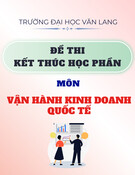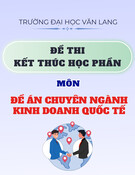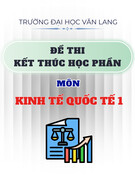
FTU Working Paper Series, Vol. 1 No. 1 (01/2022) | 51
HIỆP ĐỊNH THƯƠNG MẠI HÀNG HÓA ASEAN: CƠ HỘI VÀ THÁCH
THỨC CHO VIỆC XUẤT NHẬP KHẨU NÔNG SẢN VIỆT NAM
Nguyễn Cao Kỳ1, Lê Thanh Hà, Trần Phương Hòa, Nguyễn Tuấn Phong
Sinh viên K59 Logistics & Quản lý chuỗi cung ứng – Viện Kinh tế và Kinh doanh quốc tế
Trường Đại học Ngoại thương, Hà Nội, Việt Nam
Trịnh Hiền Lương
Sinh viên K59 CLC Kinh tế đối ngoại – Viện Kinh tế và Kinh doanh quốc tế
Trường Đại học Ngoại thương, Hà Nội, Việt Nam
Vũ Huyền Phương
Giảng viên Viện Kinh tế và Kinh doanh quốc tế
Trường Đại học Ngoại thương, Hà Nội, Việt Nam
Tóm tắt
Mục tiêu của bài nghiên cứu là chỉ ra những thành tựu và khó khăn mà hiệp định ATIGA đã đem
tới Việt Nam trong khoảng thời gian 2009 - 2017. Qua việc tìm hiểu các dữ liệu thứ cấp, việc xuất
nhập khẩu hàng hóa của Việt Nam tăng trưởng mạnh mẽ, tuy nhiên việc loại bỏ thuế nhập khẩu
dẫn tới nhiều vấn đề cho xã hội, điển hình là cạnh tranh với mặt hàng nội địa. Để giải quyết vấn
đề, chính phủ cần xây dựng, hoàn thiện hệ thống pháp luật, chính sách trong nước phù hợp với
những định hướng lớn của Đảng và nhà nước trong vấn đề phát triển thương mại, phù hợp với luật
pháp quốc tế và những khung khổ hợp tác nhằm nâng cao hiệu quả của việc tham gia vào ATIGA.
Các doanh nghiệp nên chuẩn bị kỹ lưỡng, nâng cao trang thiết bị cũng như dây chuyền sản xuất
để giảm giá bán và có thể cạnh tranh với các doanh nghiệp nước ngoài.
Từ khóa: Hiệp định ATIGA, Xuất nhập khẩu Việt Nam, cắt giảm thuế quan.
ASEAN TRADE IN GOODS AGREEMENT: OPPORTUNITIES AND
CHALLENGES FOR IMPORT AND EXPORT AGRICULTURAL PRODUCTS
OF VIETNAM
Abstract
This paper indicates the opportunities and challenges that the ATIGA agreement affects Vietnam.
The information is collected during the period 2009-2017. Through researching, Vietnam exported
and imported goods has increased significantly, however eliminating tariffs on imported goods has
led to many problems, primely on domestic products competition. To solve this and many other
disadvantages, the Vietnamese government should build and perfect the legal framework and
1 Tác giả liên hệ, Email: caoky17122002@gmail.com.
Working Paper 2022.1.1.04
- Vol 1, No 1

FTU Working Paper Series, Vol. 1 No. 1 (01/2022) | 52
policies in line with the great orientation of the Party and the Government of Vietnam in order to
improve the effectiveness of participating in ATIGA. Enterprises should be well -prepared,
improve both production line and technology so that total cost will be lower and then can easily
compete with other foreign products.
Keywords: ATIGA, Vietnam export, Vietnam import, tariff reduction.
1. Introduction
During the integration period, countries from South East Asia and throughout the world are
eager to trade commodities. Vietnam is a country in the center of South East Asia that is perfect
for importing and exporting goods. This provides Vietnam with numerous benefits, including a
wealth of natural resources, plus an abundance of human resources. Vietnam has a strong potential
for producing a variety of products, particularly agricultural items. ATIGA, or the ASEAN Trade
in Goods Agreement, is an agreement between ASEAN member countries to eliminate tariffs. The
signing of ATIGA has greatly improved Vietnam's export and import to ASEAN member
countries. The agreement has also assisted in opening up, creating many new opportunities for
these industries to develop in the future in this large potential and competitive market. However,
in addition to the benefits that ATIGA provides for Vietnam, the agreement also brings with it
difficulties and inadequacies. As a result, understanding the agreement's benefits and drawbacks
will assist manufacturers and businesses in the Vietnamese agricultural sector in improving their
weaknesses and capitalizing on the benefits provided by ATIGA. There is no denying that the
exporting and importing industry for agricultural products is extremely important for Vietnam,
mainly with high demands and the development potential is greater and clearer than ever. In this
paper, we will analyze the positives, negatives, advantages and disadvantages of exporting and
importing for the Vietnamese agricultural product industry since the ATIGA agreement came into
effect, the authors use annual time-series data of 10 member states of the ATIGA, involving 10
South East Asia countries and Vietnam between 2009 and 2017.
2. ASEAN Trade in Goods Agreement ATIGA
2.1. Overview of ATIGA
2.1.1. Formation history
● The ATIGA Agreement (ASEAN Trade in Goods Agreement) was signed in February
2009 and came into force on May 17, 2010, formerly known as the Common Effective Preferential
Tariff Agreement (CEPT/AFTA) signed in 1992;
● ATIGA is ASEAN's first comprehensive agreement that governs all regional trade in goods
and is built on the basis of a combination of tariff reduction/elimination commitments agreed in
CEPT/AFTA along with other agreements and decrees;
● Vietnam joined ASEAN in 1995 and started to implement CEPT/AFTA in 1996 and then
continued to follow ATIGA.
2.1.2. Content of the Agreement
● ASEAN countries in ATIGA give each other preferential treatment equivalent to or more
favorable than that accorded to partner countries in the Free Trade Agreements (FTAs) that
ASEAN has signed (ASEAN + FTA);

FTU Working Paper Series, Vol. 1 No. 1 (01/2022) | 53
● In order to fully liberalize the tariffs, ASEAN has agreed to eliminate all tariffs, for
ASEAN-62 by 2010 and for CLMV3 countries in 2015 with some flexibility to 2018 (about 7% of
total tariff lines);
● In addition to tariff commitments, ATIGA also includes various accords such as the
elimination of non-tariff barriers, regulations of origin, trade facilitation, customs, standards and
conformity, sanitary and phytosanitary measures;
● The tariff reduction commitment schedule in each country's ATIGA (Annex 2 of the
Agreement) includes all products in the ASEAN Tariff Goods List (AHTN - Asean Harmonised
Tariff Nomenclature) and a specific reduction schedule for each product in each year.
2.2. Commitments
2.2.1 Reduction or Elimination of Import Duties
In this commitment, Member States shall eradicate import taxes on all products traded
between the Member States for ASEAN-6 (by 2010) and for CLMV (by 2015) with a grace period
of up to 2018.
“Each Member States shall reduce and/or eliminate import duties on originating goods of the
other Member States in accordance with the following modalities: Import duties on the products
listed in Schedule A of each Member State’s tariff liberalization schedule shall be eliminated by
2010 for ASEAN-6 and 2015 for CLMV, in accordance with the schedule set out therein” (ATIGA
final paper)
To be specific,
For ASEAN-6: Import taxes of at least 80% tariff line are eliminated by 1st January, 2009 and
on all products traded between the Member States by 2010.
For CLMV: Import taxes on all products traded between the Member States are eradicated by
2015. Import duties on some CLMV products must be eliminated by 2018, (not surpassing 7% of
tariff lines).
In Vietnam, according to the information from the Ministry of Finance, Vietnam has
decreased 6,897 tariff lines (accounting for 72 percent of the total import tariff) to 0% as of January
1, 2014, as a result of ATIGA pledges. Other 1,706 tariff lines were reduced to 0% by January 1,
2015. Cars, motorcycles, accessories and spare parts for automobiles and motorcycles, vegetable
oils, tropical fruits, electronics such as refrigerators and air conditioners, milk and dairy products
will be among the remaining 669 tariff lines (accounting for 7% of the tariff line), which are
primarily sensitive products in trade between Vietnam and ASEAN, will be reduced to 0% in 2018.
Products that are not subjected to import tax removal (maintaining the MFN tax rate), include
cigarettes, tobacco leaves, defense and security products such as explosives, weapons,
pyrotechnics, medical waste, and old tires.
2.2.2. Rules of Origin
2 ASEAN-6: included Brunei, Indonesia, Malaysia, Philippines, Thailand and Singapore.
3 CLMV: included Cambodia, Laos, Myanmar, Vietnam.

FTU Working Paper Series, Vol. 1 No. 1 (01/2022) | 54
If a good imported into the territory of a Member State from another Member State meets the
origin requirements under any of the following situations, it is considered as an originating good:
(a) a good obtained or manufactured entirely in the exporting Member State.
(b) a good that was not entirely obtained or manufactured in the exporting Member State, as
long as the said goods are qualified.
Goods are considered to have originated in the Member State where they have been worked
or processed:
(a) If the commodities have a regional value content of at least 40% (hence referred to as
“ASEAN Value Content” or the “Regional Value Content (RVC)”)
(b) If all non-originating materials utilized in the goods' manufacture have experienced a
change in the Harmonized System's tariff classification (hereinafter referred to as "CTC") at the
four-digit level.
In short, the ATIGA General Rules for Rules of Origin are RVC 40% or a 4-digit level change
of tariff classification. This rule applies across the board except for the commodities stated in the
Product Specific Rules.
2.2.3. Trade Facilitation
To ensure successful implementation of trade facilitation measures, Member States will
conduct assessments once every two years, independently and collaboratively, on the
implementation of the trade facilitation measures set out in this Agreement and the ASEAN Trade
Facilitation Work Programme. Within 6 months of the Agreement's entrance into force, Member
States will agree on an ASEAN Trade Facilitation Framework to serve as a roadmap for further
improving trade facilitation in ASEAN.
In accordance with the provisions of the Agreement to Establish and Implement the ASEAN
Single Window and the Protocol to Establish and Implement the ASEAN Single Window, Member
States shall take the necessary steps to establish and operate their respective National Single
Windows and the ASEAN Single Window. At the national level, each Member State must also
create a Trade Facilitation Coordinating Committee or relevant focal point.
2.2.4. Customs
Each Member State is responsible for ensuring that its customs processes and practices are
predictable, consistent, transparent, and trade-facilitating, including through expedited goods
clearance. Member States' customs procedures follow the World Customs Organisation’s and
other international organizations' standards and recommended practices, to the extent permissible
by their own customs laws.
Each Member State's customs authorities will assess its procedures with a view to their
simplification in order to facilitate trade. Customs control will be limited to what is required to
ensure that Member States' customs regulations are followed. Member States may, to the degree
permitted by their legislation, assist each other on customs problems as deemed appropriate.
2.2.5. Standards, technical regulations and conformity assessment procedures

FTU Working Paper Series, Vol. 1 No. 1 (01/2022) | 55
The goal of this commitment is to establish provisions on standards, technical regulations, and
conformity assessment procedures to ensure that they do not obstruct trade in the process of
establishing ASEAN as a single market and production base, while also ensuring that Member
States' legitimate objectives are met.
Member States must take all necessary steps to ensure that all ASEAN Sectoral Mutual
Recognition Arrangements, ASEAN Harmonised Regulatory Regimes, and relevant provisions of
this Agreement are implemented within the time frames set forth in the aforementioned
agreements, and that the harmonised requirements are met.
2.2.6. Sanitary and phytosanitary measures
The objectives of this commitment are to strengthen the co-operation and facilitate commerce
between and among Member States while safeguarding human, animal, plant life and health in
each of them and then offer a structure and recommendations for Member States to follow when
applying sanitary and phytosanitary measures, with a focus on meeting the ASEAN Economic
Community Blueprint's commitments.
An ASEAN Committee on Sanitary and Phytosanitary Measures (AC-SPS) must be formed
for the efficient implementation of this commitment, with meetings held at least once a year among
Member States.
In accordance with the aforementioned objectives and the commitments set forth in the
ASEAN Economic Community Blueprint, each Member State will explore some opportunities for
additional cooperation, technical assistance, collaboration, and information exchange with other
Member States on sanitary and phytosanitary issues of mutual interest.
3. Achievements and problems of agreements to Import and Export Agricultural Products
of Vietnam
3.1. Achievement
3.1.1. Overview
Since signing ASEAN Trade in Goods Agreement (ATIGA), Vietnam goods exported and
imported to the Member States of ASEAN have changed. There are two main periods for Import
and Export Agricultural Products of Vietnam: Period between 2009 – 2015 and period between
2015 – 2017.


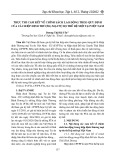
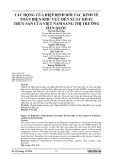
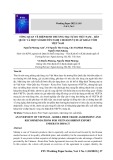
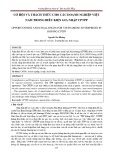







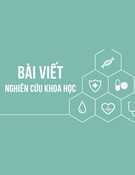
![Đề thi cuối kì Chính sách thương mại quốc tế: Tổng hợp [năm]](https://cdn.tailieu.vn/images/document/thumbnail/2025/20251112/llinhlinhlinhlinhh@gmail.com/135x160/60241762917589.jpg)




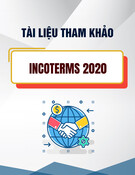

![Đề thi Luật Thương mại quốc tế học kì 1 năm 2024-2025 có đáp án (Đề 1) - [kèm đề thi]](https://cdn.tailieu.vn/images/document/thumbnail/2025/20250925/kimphuong1001/135x160/14521758785752.jpg)
